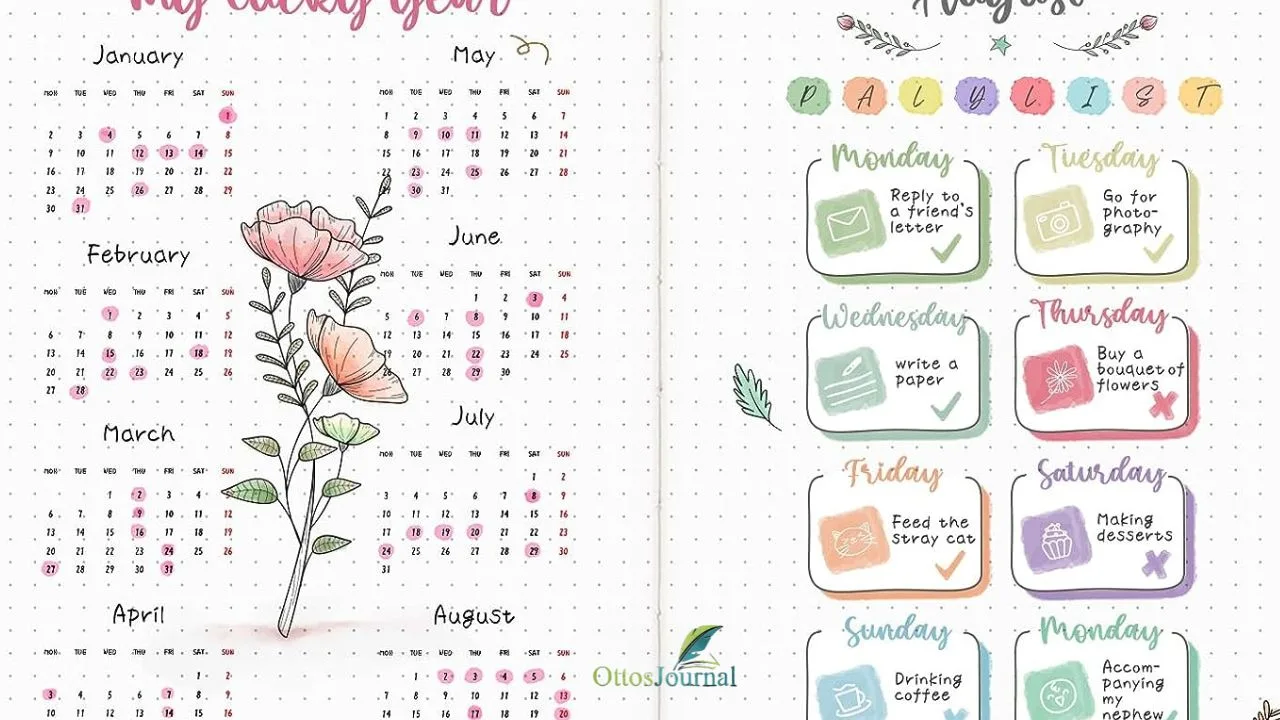Journaling has been a popular practice for many years, with people using it as a way to express their thoughts, emotions, and ideas. It has also become a tool for personal growth and development. With the rise of different journaling techniques, one method that has gained popularity is dot grid journaling. In this blog post, we’ll discuss what is dot grid journaling, how it works and how to start using it.
What is dot grid journaling?
Dot grid journaling is a creative and flexible form of journaling that utilizes dotted pages, commonly found in dot grid notebooks. Instead of traditional lined or grid paper, dot grids provide a subtle guide for writing or sketching.
This style, often associated with bullet journaling, allows users to draw straight lines and create structured layouts. Dot grid journals offer the perfect balance between the structure of grid paper and the freedom of plain paper, making them versatile for various purposes, such as note-taking, planning, and artistic expression.
How does grid journaling work?
Grid journaling involves using dot grids, a network of evenly spaced dots, on each page. These dots act as a guide for maintaining alignment and creating organized layouts. The user can draw straight lines, design charts, or customize the page to suit their needs.
The dot grid provides a structured framework without the constraints of traditional lined or grid paper. This allows for a more personalized and creative approach to journaling, making it an ideal method for those who want a versatile and visually appealing way to organize thoughts, ideas, or tasks.
What are the benefits of using a dot grid journal?
Dot grid journals offer numerous benefits. The dotted pages provide flexibility for both written content and artistic elements. The dot grid’s subtle guidance allows users to draw straight lines effortlessly, creating neat layouts for to-do lists, habit trackers, or calendars.
The lay-flat design enhances the writing experience. Whether for bullet journaling or traditional note-taking, dot grid journals strike a perfect balance between structure and freedom, catering to various preferences and purposes.
How do I use a dot grid journal?
- Bullet Journaling: Create organized to-do lists and track tasks using symbols and short entries.
- Creative Sketching: Use the dot grid to draw straight lines and create intricate designs or illustrations.
- Customized Calendars: Design personalized monthly or weekly calendars to plan events and appointments.
- Habit Tracking: Utilize dot grids to monitor and visualize progress on habits and goals.
- Mind Mapping: Connect ideas visually by drawing lines and clusters to represent relationships and concepts.
- Goal Setting: Outline short-term and long-term goals, breaking them down into manageable tasks.
- Note-Taking: Take organized notes with the help of the dot grid, maintaining neatness and structure on each page.

What are some creative ways to use a dot grid journal?
Embrace the creative potential of dot grid journals by:
- Art Journaling: Combine text and visuals for expressive artistic entries.
- Collage Pages: Use washi tape and cutouts to create visually appealing collages.
- Quote Collections: Design aesthetically pleasing pages featuring your favorite quotes.
- Doodle Pages: Allow free-form doodles to flow across the dot grid, creating unique patterns.
- Theme-Based Pages: Dedicate sections to specific themes, such as travel or seasonal topics, for a cohesive and visually engaging journal.
How can I use a dot grid journal to improve my productivity?
Enhance productivity with a dot grid journal by:
- To-Do Lists: Organize tasks and priorities using bullet points for clarity.
- Time Blocking: Allocate specific time slots for tasks, enhancing time management.
- Goal Mapping: Break down large goals into actionable steps, tracking progress on dotted pages.
- Reflection Pages: Dedicate space for reflections on achievements, challenges, and lessons learned.
- Routine Tracking: Monitor daily habits and routines, ensuring consistency and productivity.
What are some tips for beginners who are starting dot grid journaling?
For beginners in dot grid journaling:
- Start Simple: Begin with basic layouts before experimenting with complex designs.
- Use Pencil Guidelines: Lightly sketch out ideas with a pencil to ensure precision.
- Explore Templates: Look for online templates or inspiration in blog posts for layout ideas.
- Experiment with Sections: Designate different sections for tasks, notes, and personal reflections.
- Gradually Add Details: Build complexity over time; don’t feel pressured to create elaborate spreads from the beginning.
How can I use a dot grid journal to track my habits and goals?
Employ your dot grid journal to track habits and goals by:
- Creating Habit Trackers: Dedicate pages with grids to monitor daily habits.
- Setting Goal Pages: Outline specific goals and break them down into achievable steps.
- Using Symbols: Develop a system of symbols to mark progress, making tracking efficient.
- Reviewing Regularly: Set aside time to review your habit and goal-tracking pages, adjusting strategies as needed.
What are some different types of dot grid journals available?
Various types of dot grid journals include:
- Dot Grid Notebooks: Standard notebooks with dot grids, ideal for everyday use.
- Dotted Journals: Specialized journals with dot grids, often thicker and suitable for a range of creative activities.
- bullet Journals: Dot grid journals specifically designed for the popular bullet journaling method.
- Lay Flat Designs: Journals with lay-flat designs for a seamless and convenient writing experience.
How can I find a dot grid journal that is right for me?
Find the right dot grid journal by considering:
- Paper Quality: Opt for thicker pages if using markers or watercolors.
- Cover Material: Choose between hardcover and softcover based on durability and personal preference.
- Size: Select a size that fits your needs, whether compact for portability or larger for more space.
- Additional Features: Some journals may include features like built-in bookmarks or numbered pages.
- Brand Reviews: Research reviews and recommendations from fellow dot grid journal users for insights into quality and functionality.
Where can I buy dot grid journals and accessories?
Purchase dot grid journals and accessories from:
- Stationery Stores: Visit local stationery shops for a hands-on experience and immediate purchase.
- Online Retailers: Explore online platforms like Amazon, Etsy, or specialized stationery websites for a wide selection.
- Bookstores: Check major bookstores for a variety of dot grid journals and related accessories.
- Art Supply Stores: Some art supply stores may carry specialized dot grid notebooks suitable for creative endeavors.

How much do dot grid journals typically cost?
Dot grid journals’ prices vary based on factors such as brand, size, and additional features. On average, standard dot grid notebooks may range from $5 to $20, while specialized or premium options could be priced between $20 and $50.
Consider your budget, desired features, and intended use when selecting a dot grid journal to ensure you find a balance between affordability and quality.
What do you do in a dot journal?
In a dot journal, I organize my thoughts, tasks, and goals using the unique dot grid paper. The dot grid provides subtle guidance for neat layouts without imposing the structure of straight lines.
It’s a versatile tool for bullet journaling, allowing me to create personalized spreads, habit trackers, and to-do lists. The dot grid’s flexibility fosters creativity while maintaining a clean and organized aesthetic, making it an ideal choice for anyone seeking a balance between structure and creativity in their planning.
Which is better: grid or dotted notebook?
Choosing between a grid or dotted notebook depends on personal preference and intended use. While a grid offers strict, structured lines for precision, a dotted notebook provides a more subtle guide, allowing for freeform creativity.
For those who prefer a balance between structure and flexibility, a dot grid notebook is often favored. The dot grid’s unobtrusive dots offer guidance without constraining ideas, making it suitable for various purposes, from note-taking to artistic endeavors, providing a unique and personalized experience.
What is the dotted grid?
The dotted grid, a hallmark feature of dot grid paper, consists of evenly spaced dots forming a subtle matrix across the page. Unlike the rigid structure of traditional grid paper, the dotted grid offers a more adaptable framework.
This characteristic makes it a popular choice in dot grid journals and notebooks, as it provides just enough guidance for an organization without limiting creative expression. The dotted grid strikes a perfect balance between structure and freedom, making it a versatile and user-friendly format for various applications.
How do you write on a dot grid?
Writing on a dot grid involves leveraging the dots as unobtrusive guides for maintaining consistent spacing and alignment. The dots act as reference points, facilitating straight lines without the confinement of traditional lined paper.
This flexibility is especially beneficial for bullet journaling and creative note-taking. Whether sketching, jotting down ideas, or planning, the dot grid’s unassuming structure encourages a fluid writing experience while enabling a visually appealing and organized outcome.
What does dot grid paper look like?
Dot grid paper features a subtle pattern of evenly spaced dots forming a grid across the page. The dots are strategically placed, allowing users to create straight lines, charts, and designs without the rigid constraints of traditional lined or grid paper.
The result is a clean, organized appearance with the dots acting as unobtrusive guides. Dot grid paper is visually distinct, providing structure while fostering creativity, making it an excellent choice for those who value both organization and flexibility in their writing and planning.
Is Dot Grid good for Drawing?
Yes, Dot Grid is excellent for drawing. The unobtrusive dots on the paper guide without restricting artistic freedom. Artists and doodlers find the dot grid beneficial for sketching, illustrating, and creating intricate designs.
The dots act as reference points for maintaining proportion and alignment, allowing for precise drawings. Whether you’re a professional artist or someone exploring their creative side, the dot grid’s adaptability makes it a preferred choice for those seeking a versatile canvas that combines structure with artistic expression.

How does a grid pattern work?
A grid pattern, such as the one found in dot grid paper, works by providing a subtle framework for organization and precision. The evenly spaced dots create a matrix, guiding the placement of elements on the page.
Unlike rigid grids, the dot grid’s flexibility allows for diverse applications, from drawing to note-taking. The grid pattern works by offering structure without imposing limitations, making it a user-friendly format for a range of activities where organization and creativity intersect.
Bottom line
Dot grid journals offer a unique and versatile format for planning, organizing, and creative expression. With subtle dots providing unobtrusive guidance, users can design personalized spreads and layouts that incorporate both structure and creativity on their dotted paper or dotted journal.
Whether you prefer traditional pen-and-paper methods or digital tools, dot grid notebooks are a popular choice for those seeking an adaptable and aesthetically pleasing planning experience.




